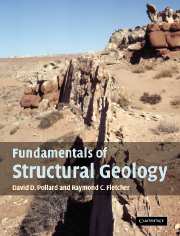Chapter 6 - Force, traction, and stress
Summary
Photoelastic image of maximum shear stress contours in grains of model rock. Stress is concentrated at grain contacts. Inset: photoelastic image of three circular disks with point contact loads. Reprinted from Gallagher et al. (1974) with permission from Elsevier.
The concept of stress is the heart of our subject. It is the unique way continuum mechanics has for specifying the interaction between one part of a material body and another (Fung, 1969, p. 41).
In this chapter we define the relationships among forces, tractions, and stresses. One of the first concepts encountered in a physics class is that of the resultant force, F, acting on a particle with mass, m, and the associated linear acceleration, a, of that particle in the direction that the force acts (Fig. 6.1a). For a rigid body (Fig. 6.1b) one considers, for example, the resultant torque, τ, about the axis z, due to the force, f, acting at position, r, and the associated angular acceleration. For a deformable body the traction vector, t(n), is a measure of force per unit area acting on the surface of a body (Fig. 6.1c), where the surface has an orientation specified by the outward unit normal vector, n. This surface can be the exterior boundary of a rock mass or an imagined surface within the rock mass. The traction vector is defined at a point on such a surface in a limiting process as the area of a small element of this surface shrinks toward zero about the point.
- Type
- Chapter
- Information
- Fundamentals of Structural Geology , pp. 194 - 242Publisher: Cambridge University PressPrint publication year: 2005



